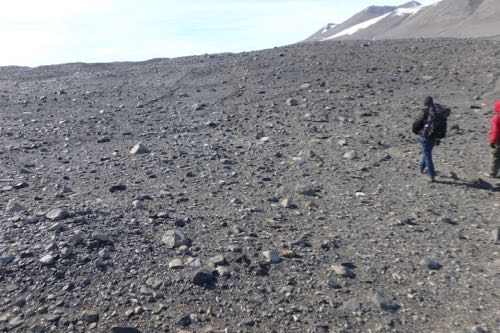Journal Entry
 Here is a video of my hike above our Lake Fryxell Camp during an Antarctic storm. I also find (and show you) another seal mummy up on this climb.
Here is a video of my hike above our Lake Fryxell Camp during an Antarctic storm. I also find (and show you) another seal mummy up on this climb.
 I'm sure you 9th grade Biology students will love this picture. While on a hike along the shore of Lake Fryxell today, I came across this seal. We have found several other seal remains in the dry valleys, but this one seems to be the most intact. From its size, and its teeth, scientists here say it is a leopard seal. Leopard seals are the top of the marine food chain around here. Their size is comparable to a grizzly bear.
I'm sure you 9th grade Biology students will love this picture. While on a hike along the shore of Lake Fryxell today, I came across this seal. We have found several other seal remains in the dry valleys, but this one seems to be the most intact. From its size, and its teeth, scientists here say it is a leopard seal. Leopard seals are the top of the marine food chain around here. Their size is comparable to a grizzly bear.
What's an Antarctic Polygon?
 Walking along a polygon. These cracks look like they are formed from running water. Not so.
Walking along a polygon. These cracks look like they are formed from running water. Not so.
 Look close and you can see cracks in the soil that look like past stream beds. Nope, they are polygons. Check out the 60-second video below to hear the explanation for how polygons form.
Look close and you can see cracks in the soil that look like past stream beds. Nope, they are polygons. Check out the 60-second video below to hear the explanation for how polygons form.
 I offered to cook dinner tonight. Looking in the freezer in the hut, we found shrimp, chicken, and sausage. With a little improvisation, I ended up putting together a nice sized pot of gumbo.
I offered to cook dinner tonight. Looking in the freezer in the hut, we found shrimp, chicken, and sausage. With a little improvisation, I ended up putting together a nice sized pot of gumbo.
 Dr. Mark Salvatore (on the left) and Dr. Lee Stanish (on the right) are sharing with us their science they have been working on. They have taught me how they use satellite images to find places on the surface of the Earth where chlorophyl is present. Chlorophyl means there is photosynthesis going on there. They use those images from space to direct their places to hike to where they can find "mats" of microbial life.
Dr. Mark Salvatore (on the left) and Dr. Lee Stanish (on the right) are sharing with us their science they have been working on. They have taught me how they use satellite images to find places on the surface of the Earth where chlorophyl is present. Chlorophyl means there is photosynthesis going on there. They use those images from space to direct their places to hike to where they can find "mats" of microbial life.
Evening Hike Adventures
 I left for a hike this evening about 9pm and headed for the mountains behind our hut. I was in for a bit of adventure and discovery.
I left for a hike this evening about 9pm and headed for the mountains behind our hut. I was in for a bit of adventure and discovery.
 While on my hike this evening, I came upon this rock. If you look close you will see a little arch cut out of it. This is not soft sandstone. It is a harder granite / gneiss type of rock. I assume this hole has been drilled out of the rock by the strong katabatic winds coming off of the polar plateau.
While on my hike this evening, I came upon this rock. If you look close you will see a little arch cut out of it. This is not soft sandstone. It is a harder granite / gneiss type of rock. I assume this hole has been drilled out of the rock by the strong katabatic winds coming off of the polar plateau.
Now, for the real mystery of the night...
 I had been hiking up the mountain behind camp when I walked upon this guy. Yep, another dead seal. Not on the floor of the valley, but hundreds of feet up the side of the mountain.
I had been hiking up the mountain behind camp when I walked upon this guy. Yep, another dead seal. Not on the floor of the valley, but hundreds of feet up the side of the mountain.
 If you can zoom up at this seal's teeth, you will see they have notches in them. These are different from the leopard seal I showed you earlier. Those teeth were just smooth, sharp teeth. These notches in the teeth tells me this is a crabeater seal. Zoom up close to those teeth in the middle. They look like crab claws to me. How do you think this poor thing got hundreds of feet up this mountain side, about 25 miles away from the ocean?
If you can zoom up at this seal's teeth, you will see they have notches in them. These are different from the leopard seal I showed you earlier. Those teeth were just smooth, sharp teeth. These notches in the teeth tells me this is a crabeater seal. Zoom up close to those teeth in the middle. They look like crab claws to me. How do you think this poor thing got hundreds of feet up this mountain side, about 25 miles away from the ocean?


Comments
Add new comment